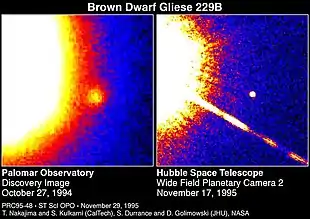Gliese 229
Gliese 229 (Gl 229, GJ 229) ist ein Stern im Sternbild Hase. Es handelt sich dabei um ein Doppelsystem in 18,8 Lichtjahren Entfernung.
| Doppelstern Gliese 229 | ||||||||||||||||||||||||||
|---|---|---|---|---|---|---|---|---|---|---|---|---|---|---|---|---|---|---|---|---|---|---|---|---|---|---|
 | ||||||||||||||||||||||||||
| links: Entdeckung von GJ 229 B am Palomar-Observatorium rechts: Aufnahme des Hubble Space Telescope (NASA) | ||||||||||||||||||||||||||
 | ||||||||||||||||||||||||||
| Beobachtungsdaten Äquinoktium: J2000.0, Epoche: J2000.0 | ||||||||||||||||||||||||||
| AladinLite | ||||||||||||||||||||||||||
| Sternbild | Hase | |||||||||||||||||||||||||
| Rektaszension | 06h 10m 34,6s[1] | |||||||||||||||||||||||||
| Deklination | −21° 51′ 52,7″[1] | |||||||||||||||||||||||||
| Scheinbare Helligkeit [1] | 8,12 mag | |||||||||||||||||||||||||
| Bekannte Exoplaneten |
2 [2] | |||||||||||||||||||||||||
| Position des Begleiters (JD 2450398) | ||||||||||||||||||||||||||
| Winkelabstand | 7",674 ± 0",007 | |||||||||||||||||||||||||
| Positionswinkel | 163°,91 ± 0°,10 | |||||||||||||||||||||||||
| Astrometrie | ||||||||||||||||||||||||||
| Parallaxe | 173,57 ± 0,02 173,70 ± 0,05 mas[1][3] | |||||||||||||||||||||||||
| Entfernung | 18,78 ± 0,01 Lj (5,76 ± 0,01 pc) | |||||||||||||||||||||||||
| Einzeldaten | ||||||||||||||||||||||||||
| Namen | A; B | |||||||||||||||||||||||||
| Beobachtungsdaten: | ||||||||||||||||||||||||||
| Scheinbare Helligkeit [1] | A | 8,13 mag | ||||||||||||||||||||||||
| B | ||||||||||||||||||||||||||
| Typisierung: | ||||||||||||||||||||||||||
| Spektralklasse[1][3] | A | M1 V | ||||||||||||||||||||||||
| B | T7pec | |||||||||||||||||||||||||
| B−V-Farbindex[1] | A | (1,48) | ||||||||||||||||||||||||
| U−B-Farbindex[1] | A | (1,19) | ||||||||||||||||||||||||
| Physikalische Eigenschaften: | ||||||||||||||||||||||||||
| rel. Helligkeit (G-Band)[1] |
A | 7,31 ± 0,01 mag | ||||||||||||||||||||||||
| B | ||||||||||||||||||||||||||
| rel. Helligkeit (J-Band)[1][4] |
A | 5,10 ± 0,04 mag | ||||||||||||||||||||||||
| B | 14,01 ± 0,05 mag | |||||||||||||||||||||||||
| Masse[5][3] | A | (0,563 ± 0,042) M☉ | ||||||||||||||||||||||||
| B | (0,067 ± 0,005) M☉ | |||||||||||||||||||||||||
| Radius[5] | A | (0,547 ± 0,044) R☉ | ||||||||||||||||||||||||
| B | ||||||||||||||||||||||||||
| Leuchtkraft[6] | A | 0,03 L☉ | ||||||||||||||||||||||||
| B | ||||||||||||||||||||||||||
| Effektive Temperatur[6][7] | A | 3560 K | ||||||||||||||||||||||||
| B | ~850 K | |||||||||||||||||||||||||
| Andere Bezeichnungen und Katalogeinträge | ||||||||||||||||||||||||||
| ||||||||||||||||||||||||||
Bei Gliese 229 A handelt es sich um einen Roten Zwerg vom Spektraltyp M1, bei Gliese 229 B um einen Braunen Zwerg der Spektralklasse T7pec mit der 70-fachen Jupitermasse und einer Oberflächentemperatur von etwa 850 Kelvin. Die Entfernung der beiden Komponenten beträgt etwa 50 Astronomische Einheiten.
Bei Gliese 229 B handelt es sich um den ersten zweifelsfrei nachgewiesenen Braunen Zwerg (Nakajima et al., 1995).[8]
Im Jahre 2014 wurde außerdem ein Exoplanet um Gliese 229 A entdeckt (Gliese 229 A b)[6] und im Jahre 2020 ein weiterer.[9]
Tabelle
| Planet (Reihenfolge vom Stern aus) |
Entdeckt | Masse (Erdmassen) |
Große Halbachse der Bahn (AU) |
Umlaufzeit (Tage) |
Exzentrizität |
|---|---|---|---|---|---|
| Gliese 229 A c | 2020 | 7,93 +2,39−3,44 | 0,339 +0,024−0,029 | 122,0 ± 0,4 | 0,29 +0,06−0,26 |
| Gliese 229 A b | 2014 | 10,02 +3,35−6,10 | 0,896 +0,069−0,073 | 523,2 +13,0−7,0 | 0,17 +0,07−0,17 |
Weblinks
Commons: Gliese 229 – Sammlung von Bildern, Videos und Audiodateien
- Nadja Podbregar: Der erste eindeutige Braune Zwerg: Gliese 229b. In: scinexx.de. 7. Mai 2010.
Einzelnachweise
- HD 42581. In: SIMBAD. Centre de Données astronomiques de Strasbourg, abgerufen am 6. Juni 2022.
- GJ 229 A Overview. NASA Exoplanet Archive, abgerufen am 6. Juni 2022.
- J. Davy Kirkpatrick, Christopher R. Gelino, Jacqueline K. Faherty, Aaron M. Meisner, Dan Caselden, Adam C. Schneider, Federico Marocco, Alfred J. Cayago, R. L. Smart, Peter R. Eisenhardt, Marc J. Kuchner: The Field Substellar Mass Function Based on the Full-sky 20 pc Census of 525 L, T, and y Dwarfs. In: The Astrophysical Journal Supplement Series. 253. Jahrgang, Nr. 1, 2021, S. 7, doi:10.3847/1538-4365/abd107, arxiv:2011.11616, bibcode:2021ApJS..253....7K.
- HD 42581 B. In: SIMBAD. Centre de Données astronomiques de Strasbourg, abgerufen am 6. Juni 2022.
- P. E. Kervella, F. Arenou, F. Mignard, F. Thévenin: Stellar and substellar companions of nearby stars from Gaia DR2. Binarity from proper motion anomaly. In: Astronomy & Astrophysics. 623. Jahrgang, März 2019, S. A72, doi:10.1051/0004-6361/201834371, arxiv:1811.08902, bibcode:2019A&A...623A..72K.
- M. Tuomi et al.: Bayesian search for low-mass planets around nearby M dwarfs – estimates for occurrence rate based on global detectability statistics. In: MNRAS. 441. Jahrgang, Nr. 2, Juni 2014, S. 1545–1569, doi:10.1093/mnras/stu358, arxiv:1403.0430, bibcode:2014MNRAS.441.1545T.
- T. Nakajima, T. Tsuji, Y. Takeda: Physical Properties of Gliese 229B Based on Newly Determined Carbon and Oxygen Abundances of Gliese 229A. In: The Astronomical Journal. 150. Jahrgang, Nr. 2, August 2015, doi:10.1088/0004-6256/150/2/53, arxiv:1506.03178, bibcode:2015AJ....150...53N.
- T. Nakajima et al.: Discovery of a cool brown dwarf. In: Nature. 378. Jahrgang, Nr. 6556, 1995, S. 463–465, doi:10.1038/378463a0, bibcode:1995Natur.378..463N.
- Fabo Feng et al.: Search for Nearby Earth Analogs.II. detection of five new planets, eight planet candidates, and confirmation of three planets aroundnine nearby M dwarfs∗. In: The Astrophysical Journal Supplement Series. 246. Jahrgang, Nr. 1, doi:10.3847/1538-4365/ab5e7c, arxiv:2001.02577, bibcode:2020ApJS..246...11F.
This article is issued from Wikipedia. The text is licensed under Creative Commons - Attribution - Sharealike. Additional terms may apply for the media files.
